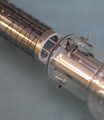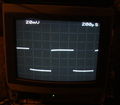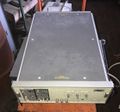7912: Difference between revisions
No edit summary |
No edit summary |
||
| Line 14: | Line 14: | ||
* [http://w140.com/7912ad_reading_gun_supply.pdf 7912AD Video preamp/Reading gun supply schematics] | * [http://w140.com/7912ad_reading_gun_supply.pdf 7912AD Video preamp/Reading gun supply schematics] | ||
* [http://w140.com/7912ad_writing_gun_supply.pdf 7912AD Z-Axis/HV board schematics] | * [http://w140.com/7912ad_writing_gun_supply.pdf 7912AD Z-Axis/HV board schematics] | ||
* [[Media:1350 070-1888-00.pdf|1350 Memory Display Unit for R7912 (PDF)]] | |||
* ''complete service manual needed [[Category:Manual needed]]'' | * ''complete service manual needed [[Category:Manual needed]]'' | ||
}} | }} | ||
Revision as of 14:32, 28 December 2018
The Tektronix 7912 is a series of high-speed digitizers that take one 7000-series vertical plug-in and one 7000-series horizontal plug-in.
All 7912 models use the same internal CRT-based, digitizing scan converter tube (T7912) that is not visible from the outside. The signal from the vertical plug-in deflects a writing beam through distributed deflection plates. The electrons hit a small flat rectangular solid state target, conceptually similar to the image sensor in a digital camera. The resolution of the target is 512×512, giving 512 points in the time domain and 9-bit linear quantization of the input voltage.
With a 7B92 sweeping the whole X-axis in 5 ns, and the 7912 capturing 512 samples in that sweep, the 7912 performs the function of a 100 GSample/s A/D converter.
The primary markets for the 7912 series were nuclear and laser research.
R7912
The R7912, introduced in September 1973 (Ref.1), achieved a bandwidth of 500 MHz with a 7A19 vertical amplifier plug-in. It was also possible, like in the 7904 scope, to access the CRT deflection plates directly through a 7A21N plug-in and achieve a bandwidth of 1 GHz, albeit at reduced sensitivity (4 V/Div) and loss of triggering and readout functions. Some customers further modified the stock 7912 to increase bandwidth up to 3 GHz in special applications (see literature links below).
The reading beam operates differently depending on the output mode. In TV mode, the reading beam scans the target in a horizontal format similar to that used in conventional television systems, and a video output compatible with TV monitors is generated. In Digital mode, the reading beam scans the target vertically, in 512 discrete steps for each of 512 horizontal positions. Waveforms are converted to digital, stored in memory, and can be read by a computer.
The R7912 used the 7000 series readout system writing readout characters onto the storage target, which would become part of the output signal in the NON STORE mode.
The R7912 had a proprietary digital interface. A card for interfacing to a DEC PDP-11 was available. The Tektronix 067-0679-00 Digital Display Controller is an external module that interfaces with the 7912 and an analog X-Y storage display (607?). Tek also offered configurations with multiple R7912s on a common controller within the WP2000 series.
7912AD and 7912HB
From the 7912AD (1978) on, the instrument had a standard GPIB interface. The 7912AD has 500 MHz bandwidth. It was succeeded by the 750 MHz 7912HB in 1987 (using a 7A29P amplifier).
For the 7912AD and 7912HB, special GPIB-controllable plug-in modules with a 'P' suffix, meaning Programmable, were available, e.g. 7A16P, 7A29P and 7B90P.
Internals
Three output methods are provided: NTSC-out, X-Y low-speed analog, and a GPIB interface.
With aftermarket modifications to the electronics, 7912AD bandwidths have been extended up to 3 GHz in special cases.
Specifications
The Tektronix 7912AD is 19" wide, 7" tall, 27" deep, and weighs 55 pounds. It uses 360 watts maximum.
Literature and Software
- Hale Farley, The introduction of the R7912 in Tek Retirees Newsletter 11/2012
- US Patent 3748585: Silicon Diode Array Scan Converter Tube and Method of Operation. Culter et al, July 1973.
- LLE Review, Oct-Dec 1985 mentioning the LM7912A, a Lockheed-modified R7912 variant having "a bandwidth of 3.5 GHz at the -3 dB point, less than 5% undershoot and overshoot, with a 12-bit output (2 mV/bit)"
- Lockheed Palo Alto Research Lab study for LLL (June 1978) describing the LM7912 Enhanced Performance Transient Digitizer, claiming 3 GHz bandwidth
- William B. Boyer, Data Acquisition and Processing on Electron Beam Fusion Accelerators. IEEE Transactions on Nuclear Science Vol.NS-25, No. 1, February 1978
- Thesis on "7912ADM" upgrade version
- Improvement of the Bandwidth of the Transient Digitizers in the LIDAR Thomson Scattering Diagnostic on JET. Risø National Laboratory, Denmark, June 1990 discussing how removing the delay line and replacing the compensation circuit can boost the 7912AD+7A29 combination to 1.1 GHz bandwidth
- 7912 GPIB examples
Links
- Carlo Infante: A New Way to Look At Transients (R7912). In TekScope Vol. 5 No. 6, Nov-Dec 1973
- Tek R7912 @ radiomuseum.org
- Dale Aufrecht: An Intelligent, Programmable Transient Digitizer (7912AD). In TekScope Vol. 11 No. 1, 1979
- Tek 7912AD @ radiomuseum.org
See Also
- WP2051, WP2052
- SCD1000, SCD5000
- 670-6466-00 7912 AD plug-in interface extender
Pictures
R7912
-
R7912 connected to a modern video monitor. Note 7000-style readout.
-
R7912 front
-
R7912 controls
-
R7912 rear
7912AD
-
7912AD digitizer tube
-
T7912 tube - read part (left), target (center), write part (right). See T7912 article for more photos.
-
7912AD block diagram
-
7912AD front
-
WP 2000
-
WP 2000
-
WP 2000
-
7912AD TV output on NTSC monitor
-
7912AD top view, cover removed
-
7912AD IEEE 488
-
7912AD IEEE 488
-
7912AD MPU
-
7912AD MPU
-
7912AD 5156
-
7912AD 5156
-
7912AD data buffer
-
7912AD data buffer
-
7912AD translator
-
7912AD translator
-
7912AD graticule generator
-
7912AD graticule generator
-
7912AD X-Y ramp generator
-
7912AD X-Y ramp generator
-
7912AD video processor
-
7912AD 4377
-
7912AD horizontal
-
7912AD scan amplifier
-
670-6466-00 plug-in extender
-
7912AD power connector PCB
-
7912AD power connector PCB
7912HB
-
7912HB
-
7912HB
-
7912HB
-
7912HB




































